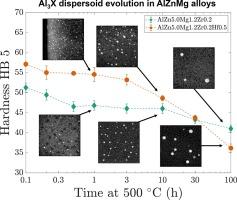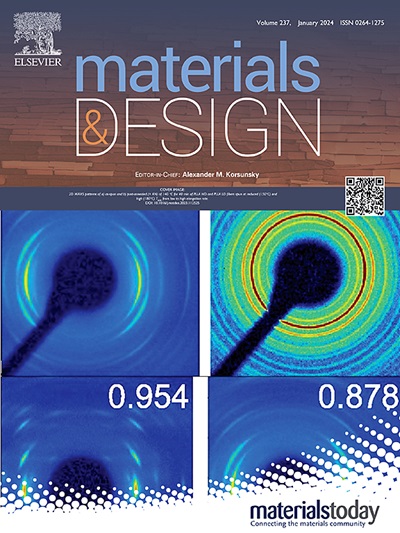Dispersoid evolution in Al–Zn–Mg alloys by combined addition of Hf and Zr: A mechanistic approach
IF 7.6
2区 材料科学
Q1 MATERIALS SCIENCE, MULTIDISCIPLINARY
引用次数: 0
Abstract
Coherent Al3X-type L12-structured dispersoids have the potential of effectively stabilizing the grain structure and increasing strength. This concept has been successfully demonstrated for non-hardenable and rapidly solidified Al alloys. In precipitation-hardened Al alloys, effective dispersoid addition requires both controlling their high-temperature stability and minimizing their impact on precipitation hardening. The current study focuses on dispersoid-modified AlZn5.0Mg1.2 alloys, which exhibit MgZn precipitation upon age-hardening and include less than 1 wt% of Zr and Hf for dispersoid formation. Heat treatments between 350 °C and 500 °C for varying times were applied to evaluate dispersoid formation, thermal stability and the related strengthening potential. The microstructure was assessed using transmission electron microscopy (TEM) and atom probe tomography (APT), and the mechanical response was evaluated by hardness testing. TEM after heating at 500 °C reveals Ostwald ripening for the dispersoids. APT results on the dispersoids reveal a core–shell structure development upon longer annealing times. The Zr–Hf-modified alloy exhibits a higher initial strength than the Zr-modified alloy but the latter displays greater strength retention even after prolonged exposure to 500 °C. This effect is attributed to a destabilization of the mixed Zr–Hf dispersoids that arises from lower enthalpic benefits of Al3Hf formation over Al3Zr.

通过联合添加 Hf 和 Zr 实现 Al-Zn-Mg 合金中的分散演变:力学方法
连贯的 Al3X 型 L12 结构分散体具有有效稳定晶粒结构和提高强度的潜力。这一概念已在非硬化和快速凝固铝合金中得到成功验证。在沉淀硬化铝合金中,要有效添加分散体,既要控制其高温稳定性,又要尽量减少其对沉淀硬化的影响。目前的研究重点是分散体改性的 AlZn5.0Mg1.2 合金,这种合金在时效硬化时会出现 MgZn 沉淀,并且在形成分散体时 Zr 和 Hf 的含量低于 1 wt%。在 350 °C 和 500 °C 之间进行不同时间的热处理,以评估分散体的形成、热稳定性和相关的强化潜力。使用透射电子显微镜(TEM)和原子探针断层扫描(APT)评估了微观结构,并通过硬度测试评估了机械响应。在 500 °C 下加热后的 TEM 显示了分散体的奥斯特瓦尔德熟化过程。关于分散体的 APT 结果显示,退火时间越长,核壳结构越发达。与 Zr 改性合金相比,Zr-Hf 改性合金的初始强度更高,但后者即使长时间暴露在 500 ℃ 下也能保持更高的强度。这种效应归因于混合 Zr-Hf 分散体的不稳定性,而这种不稳定性是由于 Al3Hf 形成的焓值低于 Al3Zr 形成的焓值。
本文章由计算机程序翻译,如有差异,请以英文原文为准。
求助全文
约1分钟内获得全文
求助全文
来源期刊

Materials & Design
Engineering-Mechanical Engineering
CiteScore
14.30
自引率
7.10%
发文量
1028
审稿时长
85 days
期刊介绍:
Materials and Design is a multi-disciplinary journal that publishes original research reports, review articles, and express communications. The journal focuses on studying the structure and properties of inorganic and organic materials, advancements in synthesis, processing, characterization, and testing, the design of materials and engineering systems, and their applications in technology. It aims to bring together various aspects of materials science, engineering, physics, and chemistry.
The journal explores themes ranging from materials to design and aims to reveal the connections between natural and artificial materials, as well as experiment and modeling. Manuscripts submitted to Materials and Design should contain elements of discovery and surprise, as they often contribute new insights into the architecture and function of matter.
 求助内容:
求助内容: 应助结果提醒方式:
应助结果提醒方式:


